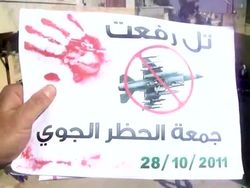Syria Special: Should We Treat Calls for a No-Fly Zone Seriously? (Zenko)
 Tuesday, November 1, 2011 at 14:37 |
Tuesday, November 1, 2011 at 14:37 |  James Miller in
James Miller in  EA Global,
EA Global,  EA Middle East and Turkey,
EA Middle East and Turkey,  Middle East and Iran,
Middle East and Iran,  US Foreign Policy
US Foreign Policy See also Bahrain, Syria (and Beyond) LiveBlog: A New Dialogue?
 http://lat.ms/vZSb3p
http://lat.ms/vZSb3pMicah Zenko, writing for The Atlantic, explores the recent calls of protesters in the streets of Syri, for a "No-Fly Zone" and an international intervention, perhaps similar to the UN resolution and the NATO mission in Libya. Zenko, considering whether or not a no-fly zone would help the protesters, doubts that such a mission is in the international playbook. The most interesting assessment --- with which we agree --- is that there is little to no evidence that the Syrian military is using air power to attack protesters.
However, the one point that Zenko does not make is that the perception of the NATO intervention in Libya has stretched the meaning of the phrase "no-fly zone" for many in the Middle East. In Libya, only the first few days or weeks of the NATO mission concentrated on Qaddadi's air power. The rest of the mission focused on hammering Qaddafi's tanks, artillery, and rocket batteries. While Syria's military may not be relying heavily on its air force, Assad's loyalists have been patrolling, and shelling, the streets of Syria with heavily armored equipment. Perhaps, to the Syrian protesters on the ground who don't speak English as their first language, a "no-fly zone" actually mean a "blow up Assad's tanks" zone?
An excerpt of the article:
Last week, Syrian opposition activists agreed on the theme of their customary end-of-week protests: "No-Fly Zone Friday." However, protests on the streets throughout Syria were less clear-cut in their demands. Protestors in Homs shouted to the international community, "God, Syria, we want a no-fly zone," while others in Damascus chanted, "people want a ban on flying." Some signs in Homs read, "A no-fly zone is a legitimate demand for Homs," or simply depicted the universal symbol of a plane within a circle, slashed through by a red line.
On No-Fly Zone Friday, government security forces killed approximately forty-four anti-regime protestors, the most in a single day since May 6, 2011. According to United Nations estimates, well over 3,000 people have been killed since the uprising began in mid-March. Notably, none of the nonviolent protestors were killed or injured by airpower.
The escalating demands for an international no-fly zone (NFZ) over Syria is puzzling, since, as I pointed out in an earlier piece, it would do nothing to protect civilians who are dying in cities by soldiers on the ground, tanks, short-range artillery, and snipers.
However, recent statements from anti-regime groups have provided further insight into what they believe a NFZ could achieve in Syria. Notably, these include many second-order effects, unrelated to the specific military mission of a NFZ: the prohibition of aircraft over a specified geographic area.
 Bashar al Assad,
Bashar al Assad,  Libya,
Libya,  NATO,
NATO,  No Fly Zone,
No Fly Zone,  Syria,
Syria,  Tanks,
Tanks,  civilian casualties
civilian casualties 
Reader Comments